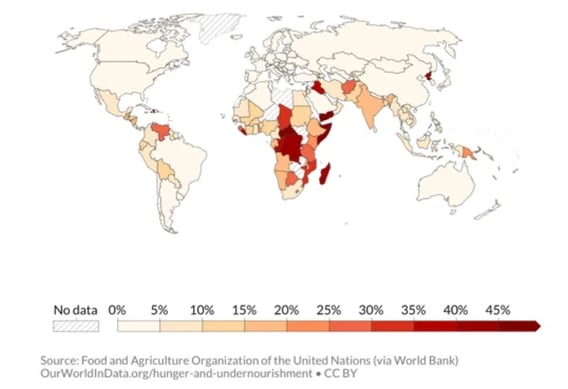Global Distribution of Food
- Food consumption around the world is increasing due to:
- Population increase: the world population has now reached 8 billion
- Much of this growth has been in LICs and NEEs where people are more likely to suffer food insecurity
- As countries develop people have money to buy more food
- Transport of food is easier and cheaper than in the past
- Population increase: the world population has now reached 8 billion
- Sufficient food is produced to feed the world's population
Food security
- The distribution of food is uneven and this affects food security

Share of people who are undernourished
- Countries where a high percentage of the population are food insecure often have a food deficit
- These tend to be LICs as they cannot produce or afford to import enough food to meet the population's needs
- Some countries have a food surplus, these tend to be HICs
- HICs and some NEEs can also afford to import food when they do not produce sufficient for the demand: the UK imports approximately 46% of the food supply required by the population
Calorie intake
- To live a healthy and active life people require about 2,500 calories
- In areas like the USA and Europe people consume more calories than needed
- In areas such as Pakistan, Venezuela and sub-Saharan Africa people consume fewer calories than needed
 Calorie intake per person
Calorie intake per person
Factors affecting food supply
- There are many factors which affect food supply either in terms of yields or transport into an area
Table Showing Impacts to Food Supply
| Factor | Affect on Food Supply |
| Climate |
|
| Technology |
LICs lack money to invest in:
This means their yields are lower than in HICs which are able to invest money in this technology |
| Pests and Diseases |
|
| Water Stress |
|
| Conflict |
|
| Poverty |
Poverty can mean that people are unable to afford:
Poor diets then mean that people are unable to work due to ill health |
Worked example
Study Figure 1, a map of South and East Asia showing the percentage of people who were undernourished between 2014 and 2016.

Figure 1
Name one country where less than 5% of the population were undernourished.
[1 mark]
Answer:
- Any of the following countries would receive 1 mark
- Brunei [1]
- Japan [1]
- Malaysia [1]
- South Korea [1]


